Journal Description
Earth
Earth
is an international, peer-reviewed, open access journal on earth science, published quarterly online by MDPI.
- Open Access— free for readers, with article processing charges (APC) paid by authors or their institutions.
- High Visibility: indexed within ESCI (Web of Science), Scopus, GeoRef, AGRIS, and other databases.
- Rapid Publication: manuscripts are peer-reviewed and a first decision is provided to authors approximately 17.6 days after submission; acceptance to publication is undertaken in 3.6 days (median values for papers published in this journal in the second half of 2023).
- Recognition of Reviewers: APC discount vouchers, optional signed peer review, and reviewer names published annually in the journal.
Latest Articles
Land Use Land Cover (LULC) Change Dynamics Associated with Mining Activities in Kitwe District and Adequacy of the Legal Framework on Mine Closure in Zambia
Earth 2024, 5(2), 110-132; https://doi.org/10.3390/earth5020006 - 31 Mar 2024
Abstract
►
Show Figures
Land use land cover (LULC) changes resulting from copper exploration in Kitwe District, Copperbelt Province has adversely impacted the environment. To understand LULC change dynamics associated with mining activities, this study mapped LULC changes using the Google Earth Engine (GEE) from 1990 to
[...] Read more.
Land use land cover (LULC) changes resulting from copper exploration in Kitwe District, Copperbelt Province has adversely impacted the environment. To understand LULC change dynamics associated with mining activities, this study mapped LULC changes using the Google Earth Engine (GEE) from 1990 to 2020. In addition, the Zambian legal framework for mine closure was assessed in terms of adequacy and comprehensiveness. A remote sensing analysis using Landsat TM (1990, 2000, and 2010) and OLI (2020) images was performed and the GEE Random Forest classifier algorithm was employed to detect LULC changes. Then, transition matrices and overall changes were calculated for each LULC class. The LULC classification had an overall accuracy and kappa coefficient of 82.47% and 0.78, respectively. In total, 45.2% of the district area (360.92 km2) experienced LULC changes from 1990 to 2020. The overall change indicates that the areas of built-up area, bare land, and grassland/pasture/agricultural land gained 35.84, 14.67, and 43.53 km2, respectively, while forest lost 95.30 km2, with the major driver being the privatization of mining companies. Several concerns regarding the mine closure process practiced in Zambia have principally been raised to the government. Although the legislation generally conformed to international best practices, a gap involving various pieces of legislation, overlapping requirements, and different interpretations of the laws by different governmental departments makes the system complex and unmanageable. An area of concern is the government’s capability and competence to implement legislation. Ineffective law enforcement, that is, the inadequacy of the legislation, is to blame for LULC changes in mining areas, resulting in mining corporations not paying attention to the changes made, particularly regarding mine closures. This study provides decision-makers and land use planners with baseline knowledge on LULC changes that can be valuable for future mining legislation and how these legislations can be effectively executed to ensure sustainable mine closure.
Full article
Open AccessArticle
Projected Heat Waves in Ecuador under Climate Change: Insights from HadGEM-RegCM4 Coupled Model
by
Diego Portalanza, Carlos Ortega, Liliam Garzon, Melissa Bello, Cristian Felipe Zuluaga, Caroline Bresciani, Angelica Durigon and Simone Ferraz
Earth 2024, 5(1), 90-109; https://doi.org/10.3390/earth5010005 - 14 Mar 2024
Abstract
►▼
Show Figures
This study examines heat wave projections across Ecuador’s Coastal, Highlands, and Amazon regions for 1975–2004 and 2070–2099 under Representative Concentration Pathways (RCP) scenarios 2.6, 4.5, and 8.5. Employing dynamic downscaling, we identify significant increases in heatwave intensity and maximum air temperatures (
[...] Read more.
This study examines heat wave projections across Ecuador’s Coastal, Highlands, and Amazon regions for 1975–2004 and 2070–2099 under Representative Concentration Pathways (RCP) scenarios 2.6, 4.5, and 8.5. Employing dynamic downscaling, we identify significant increases in heatwave intensity and maximum air temperatures (

Figure 1
Open AccessArticle
Resilience of an Urban Coastal Ecosystem in the Caribbean: A Remote Sensing Approach in Western Puerto Rico
by
Yadiel Noel Bonilla-Roman and Salvador Francisco Acuña-Guzman
Earth 2024, 5(1), 72-89; https://doi.org/10.3390/earth5010004 - 10 Feb 2024
Abstract
►▼
Show Figures
Utilization of remote sensing-derived meteorological data is a valuable alternative for tropical insular territories such as Puerto Rico (PR). The study of ecosystem resilience in insular territories is an underdeveloped area of investigation. Little research has focused on studying how an ecosystem in
[...] Read more.
Utilization of remote sensing-derived meteorological data is a valuable alternative for tropical insular territories such as Puerto Rico (PR). The study of ecosystem resilience in insular territories is an underdeveloped area of investigation. Little research has focused on studying how an ecosystem in PR responds to and recovers from unique meteorological events (e.g., hurricanes). This work aims to investigate how an ecosystem in Western Puerto Rico responds to extreme climate events and fluctuations, with a specific focus on evaluating its innate resilience. The Antillean islands in the Caribbean and Atlantic are vulnerable to intense weather phenomena, such as hurricanes. Due to the distinct tropical conditions inherent to this region, and the ongoing urban development of coastal areas, their ecosystems are constantly affected. Key indicators, including gross primary production (GPP), normalized difference vegetation index (NDVI), actual evapotranspiration (ET), and land surface temperature (LST), are examined to comprehend the interplay between these factors within the context of the Culebrinas River Watershed (CRW) ecosystem over the past decade during the peak of hurricane season. Data processing and analyses were performed on datasets provided by Moderate Resolution Imaging Spectroradiometer (MODIS) and Landsat 8–9 OLI TRIS, supplemented by information sourced from Puerto Rico Water and Energy Balance (PRWEB)—a dataset derived from Geostationary Operational Environmental Satellite (GOES) data. The findings revealed a complex interrelationship among atmospheric events and anthropogenic activities within the CRW, a region prone to recurrent atmospheric disruptions. NDVI and ET values from 2015 to 2019 showed the ecosystem’s capacity to recover after a prolonged drought period (2015) and Hurricanes Irma and Maria (2017). In 2015, the NDVI average was 0.79; after Hurricanes Irma and Maria in 2017, the NDVI dropped to 0.6, while in 2019, it had already increased to 0.8. Similarly, average ET values went from 3.2339 kg/m2/day in 2017 to 2.6513 kg/m2/day in 2018. Meanwhile, by 2019, the average ET was estimated to be 3.8105 kg/m2/day. Data geoprocessing of LST, NDVI, GPP, and ET, coupled with correlation analyses, revealed positive correlations among ET, NDVI, and GPP. Our results showed that areas with little anthropogenic impact displayed a more rapid and resilient restoration of the ecosystem. The spatial distribution of vegetation and impervious surfaces further highlights that areas closer to mountains have shown higher resilience while urban coastal areas have faced greater challenges in recovering from atmospheric events, thus showing the importance of preserving native vegetation, particularly mangroves, for long-term ecosystem stability. This study contributes to a deeper understanding of the dynamic interactions within urban coastal ecosystems in insular territories, emphasizing their resilience in the context of both natural atmospheric events and human activity. The insights gained from this research offer valuable guidance for managing and safeguarding ecosystems in similar regions characterized by their susceptibility to extreme weather phenomena.
Full article

Figure 1
Open AccessArticle
Assessing Post-Monsoon Seasonal Soil Loss over Un-Gauged Stations of the Dwarkeswar and Shilabati Rivers, West Bengal, India
by
Ankita Mukherjee, Maya Kumari and Varun Narayan Mishra
Earth 2024, 5(1), 45-71; https://doi.org/10.3390/earth5010003 - 07 Feb 2024
Abstract
►▼
Show Figures
This study employs the Soil and Water Assessment Tool (SWAT) model to evaluate soil loss within the Shilabati and Dwarkeswar River Basin of West Bengal, serving as a pilot investigation into soil erosion levels at ungauged stations during the post-monsoon season. Detailed data
[...] Read more.
This study employs the Soil and Water Assessment Tool (SWAT) model to evaluate soil loss within the Shilabati and Dwarkeswar River Basin of West Bengal, serving as a pilot investigation into soil erosion levels at ungauged stations during the post-monsoon season. Detailed data for temperature, precipitation, wind speed, solar radiation, and relative humidity for 2000–2022 were collected. A land use map, soil map, and slope map were prepared to execute the model. The model categorizes the watershed region into 19 sub-basins and 227 Hydrological Response Units (HRUs). A detailed study with regard to soil loss was carried out. A detailed examination of soil erosion patterns over four distinct time periods (2003–2007, 2007–2012, 2013–2017, and 2018–2022) indicated variability in soil loss severity across sub-basins. The years 2008–2012, characterized by lower precipitation, witnessed reduced soil erosion. Sub-basins 6, 16, 17, and 19 consistently faced substantial soil loss, while minimal erosion was observed in sub-basins 14 and 18. The absence of a definitive soil loss pattern highlights the region’s susceptibility to climatic variables. Reduced soil erosion from 2018 to 2022 is attributed to diminished precipitation and subsequent lower discharge levels. The study emphasizes the intricate relationship between climatic factors and soil erosion dynamics.
Full article
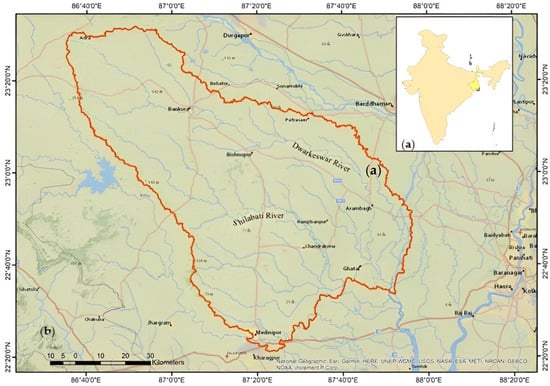
Figure 1
Open AccessArticle
Assessing Groundwater Recharge in the Wabe River Catchment, Central Ethiopia, through a GIS-Based Distributed Water Balance Model
by
Gideon Tadesse and Muralitharan Jothimani
Earth 2024, 5(1), 20-44; https://doi.org/10.3390/earth5010002 - 19 Jan 2024
Abstract
►▼
Show Figures
The utilization of groundwater has emerged as an indispensable asset in facilitating economic advancement, preserving ecological integrity, and responding to the challenges posed by climate change, especially in regions characterized by aridity and semi-aridity. The sustainable management of water resources requires an assessment
[...] Read more.
The utilization of groundwater has emerged as an indispensable asset in facilitating economic advancement, preserving ecological integrity, and responding to the challenges posed by climate change, especially in regions characterized by aridity and semi-aridity. The sustainable management of water resources requires an assessment of the geographical and temporal patterns of groundwater recharge. The present study employed the GIS-based WetSpass-M model to model the water balance components by utilizing hydro-meteorological and biophysical data from the Wabe catchment, which spans an area of 1840 km2 in central Ethiopia, for a long time. The objective of this study was to assess the long-term average annual and seasonal groundwater recharge for the catchment area utilizing the WetSpass-M model. The input data were collected through remote sensing data and surveys in the field. The model was employed to gain insights into the process of groundwater recharge in a particular region and to facilitate effective management, prudent utilization, and sustainable planning of water resources in the long run. Water balance components were estimated using seasonal fluctuations in evapotranspiration, surface runoff, and groundwater recharge. The Wabe catchment’s summer, winter, and mean long-term yearly groundwater recharge were determined to be 125.5 mm, 78.98 mm, and 204.51 mm, respectively. The model indicates that summer seasons account for 86.5% of the mean annual precipitation, while winter seasons account for 13.5%. On the other hand, the groundwater system percolates 14.8% of the total annual rainfall (1374.26 mm). While evapotranspiration accounts for 51% of total precipitation and surface runoff accounts for 34.1%, the Wabe catchment’s mean annual evapotranspiration and surface runoff values are simulated at 701.11 mm and 485.58 mm, respectively. The findings suggest the use of the WetSpass-M model to precisely calculate the water balance components within the Wabe catchment.
Full article
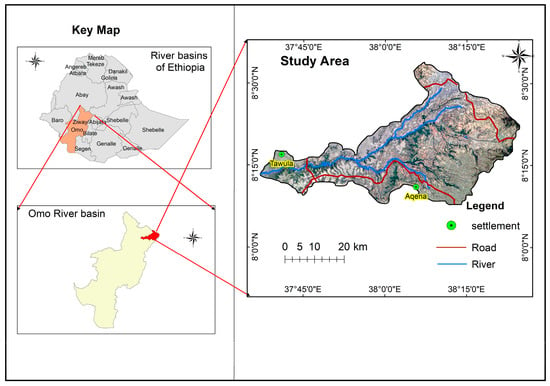
Figure 1
Open AccessArticle
Features of Degassing from Overburden Rock Massifs: A Case Study Using Radon
by
Timofey Leshukov, Aleksey Larionov, Ekaterina Nastavko, Philipp Kaizer and Konstantin Legoshchin
Earth 2024, 5(1), 1-19; https://doi.org/10.3390/earth5010001 - 25 Dec 2023
Abstract
►▼
Show Figures
Overburden rock massifs resulting from open-pit coal mining are very common objects in the world’s mining regions. These locations pose a significant challenge as the global mining industry expands. These dumps are capable of self-burning for quite a long time. The displacement and
[...] Read more.
Overburden rock massifs resulting from open-pit coal mining are very common objects in the world’s mining regions. These locations pose a significant challenge as the global mining industry expands. These dumps are capable of self-burning for quite a long time. The displacement and sliding of these massifs can cause catastrophic consequences. In addition, these objects emit a significant amount of greenhouse gases into the atmosphere. Therefore, it is necessary to manage such objects and implement appropriate measures to limit their impact on the environment. In this work, we studied soil radon volume activity (VAR) and radon flux density (RFD) on the surface of the overburden rock massif of coal-bearing mining rocks and also made visual fixation of disturbances in the body of the massif, which appeared in the process of its movement. We found anomalies of VAR and RFD on the surface of the overburden extending from north to south. These anomalies were extended along the strike of the faults found in the body of the massif. Additionally, the radon anomalies coincided with the anomalies of methane gas emission previously measured for this object. Thus, we determined that the exit of gases from the body of the massif is carried out through fault (weakened) zones in the body of the massif. According to the results of the study, we propose to carry out radon monitoring in order to detect the spontaneous ignition process of the massif or the increase of its mobility. This will also allow us to take appropriate measures to stabilize the massif or to extinguish the dump before or simultaneously with the biological stage of reclamation.
Full article
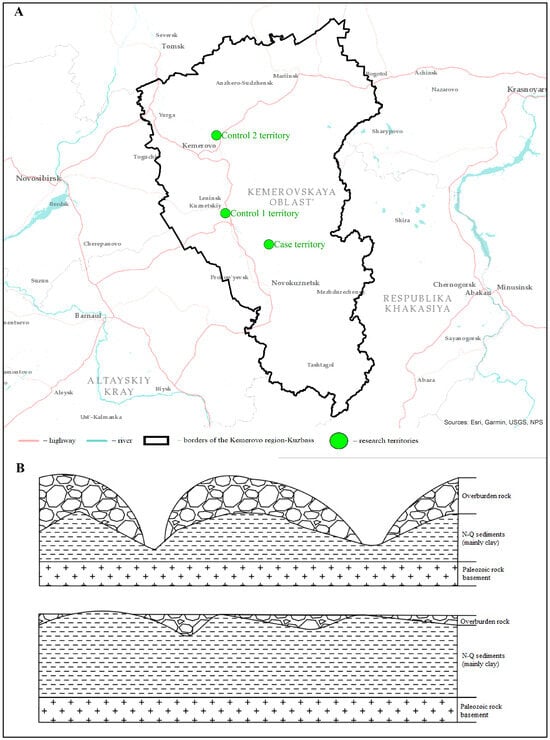
Figure 1
Open AccessArticle
Exposure to Climate Change Information on Affect and Pro-Environmental Behavioural Intentions: A Randomised Controlled Trial
by
Samantha Greaves, Caroline Harvey and Yasuhiro Kotera
Earth 2023, 4(4), 845-858; https://doi.org/10.3390/earth4040045 - 18 Dec 2023
Abstract
►▼
Show Figures
Climate change and its impact are being acknowledged through extensive media coverage. Knowledge gaps between mental health and climate change have been highlighted, which is an increasingly prevalent issue. Furthermore, mental health impacts such as climate anxiety and its implications on behaviour remain
[...] Read more.
Climate change and its impact are being acknowledged through extensive media coverage. Knowledge gaps between mental health and climate change have been highlighted, which is an increasingly prevalent issue. Furthermore, mental health impacts such as climate anxiety and its implications on behaviour remain unclear. The study aimed to investigate the effect of climate change exposure on affect and pro-environmental behavioural intentions in a randomised controlled trial. An online survey was completed by 100 adult participants and included measures of affect and pro-environmental behavioural intentions pre- and post-exposure. Participants were randomly allocated to a group that saw a climate change video (n = 55) or a group that saw a non-climate change video (n = 45). The findings were that participants in the climate change group showed a significant increase in negative affect and pro-environmental behavioural intention scores post-video exposure compared to the non-climate change video group. This suggests that climate change video exposure negatively influences affect but also potentially increases the intention to act pro-environmentally. These findings have the potential to support policies and societal change; however, further investigation into the type of contents, actual behaviour change, and impacts on diverse populations (e.g., minority groups) is needed.
Full article
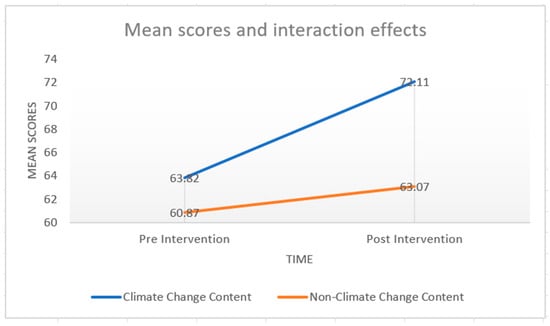
Figure 1
Open AccessArticle
Agro-Pastoral Expansion and Land Use/Land Cover Change Dynamics in Mato Grosso, Brazil
by
Sayaka Yoshikawa
Earth 2023, 4(4), 823-844; https://doi.org/10.3390/earth4040044 - 14 Nov 2023
Cited by 1
Abstract
►▼
Show Figures
Large-scale land use/land cover changes have occurred in Mato Grosso State (hereafter MT), Brazil, following the introduction of extensive mechanized agriculture and pastoral activities since the 1980s. Author investigated what kind of agro-pastoral activities which are both cattle ranching and top five crops
[...] Read more.
Large-scale land use/land cover changes have occurred in Mato Grosso State (hereafter MT), Brazil, following the introduction of extensive mechanized agriculture and pastoral activities since the 1980s. Author investigated what kind of agro-pastoral activities which are both cattle ranching and top five crops (soybean, sugarcane, corn, cotton and rice) that are closely related to land use change on lands experiencing conversion land use change (such as deforestation and the increase in deeply anthropogenically influenced areas) at each municipal district in MT. Then, this study identifies the volume of exports including contribution ratio by municipal districts where land use changed due to agro-pastoral activities. The patterns of vegetation change indicated that cattle ranching, corn, cotton, rice croplands in the northwest, and soybean and sugarcane fields in the central areas are the main contributors to deforestation. It is shown that land use change due to soybean or corn cultivation occurs mainly in the west and the southeast, respectively. Corn cultivation is associated with a greater increase in anthropogenically influenced areas than soybean cultivation. The municipal districts that export each agro-pastoral product with land use change are limited. Exports of soybeans, corn, and cotton in the municipal districts associated with deforestation had increased dramatically after experienced land use change. For example, Sapezal, which has experienced deforestation, was the only municipal district associated with export of corn to only Switzerland. Since 2007, the number of export partners has increased to 56 countries with the export volume increased 2300 times. These findings highlight the overall non-sustainability of environmental resource development activities in MT.
Full article
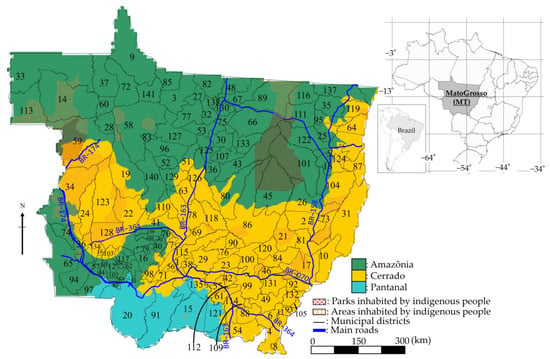
Figure 1
Open AccessArticle
An Assessment of the Epicenter Location and Surroundings of the 24 January 2020 Sivrice Earthquake, SE Türkiye
by
Mehmet Tekin Yurur, Sultan Kocaman, Beste Tavus and Candan Gokceoglu
Earth 2023, 4(4), 806-822; https://doi.org/10.3390/earth4040043 - 06 Nov 2023
Abstract
►▼
Show Figures
The Sivrice earthquake (Mw 6.8) occurred on 24 January 2020 along the East Anatolian Fault (EAF) zone of Türkiye, and epicentral information and focal mechanism solutions were published by two national and six international seismic stations. Here, we analyzed epicentral locations and the
[...] Read more.
The Sivrice earthquake (Mw 6.8) occurred on 24 January 2020 along the East Anatolian Fault (EAF) zone of Türkiye, and epicentral information and focal mechanism solutions were published by two national and six international seismic stations. Here, we analyzed epicentral locations and the major fault trace using aerial photogrammetric images taken two days after, and synthetic aperture radar (SAR) interferometry. Although the focal mechanism solutions were similar, the epicenters were largely displaced. Several bright lineaments with a stair-like geometry were observed in aerial images of the Euphrates River channel along the fault trace. These lineaments, also called en echelon fractures in structural geology, are like right-lateral segments of a fault plane aligning the river channel, cut and offset by those similar in trend with the EAF and with alignments of a left lateral sense, as is the EAF motion sense. We interpret that the river local channel follows a right-lateral fault structure. The traces were lost a few days later, which proves the essentiality of remote sensing technologies for obtaining precise information in large regions. The time series analysis for one year period from Sentinel-1 SAR data also illustrated the displacements in the region sourced from the earthquake.
Full article

Figure 1
Open AccessArticle
Evaluation of Groundwater Potential Using Aquifer Characteristics in Urambo District, Tabora Region, Tanzania
by
Athuman R. Yohana, Edikafubeni E. Makoba, Kassim R. Mussa and Ibrahimu C. Mjemah
Earth 2023, 4(4), 776-805; https://doi.org/10.3390/earth4040042 - 18 Oct 2023
Abstract
►▼
Show Figures
In developing countries like Tanzania, groundwater studies are essential for water resource planning, development, and management. Limited hydrogeological information on groundwater occurrence, availability, and distribution in Urambo District is termed a key factor that hinders groundwater development. This research was aimed at the
[...] Read more.
In developing countries like Tanzania, groundwater studies are essential for water resource planning, development, and management. Limited hydrogeological information on groundwater occurrence, availability, and distribution in Urambo District is termed a key factor that hinders groundwater development. This research was aimed at the evaluation of groundwater potential zones in a granitic gneiss aquifer in Urambo District by integrating six indicators (transmissivity, specific capacity, static water level, yield, total dissolved solids, and geology) that were developed and applied in the study area. The indicators were further combined, and a groundwater potential index map (GWPIM) was prepared using relative weights derived from the analytical hierarchy process (AHP). The results show that 67% and 27% of the study area are categorized as moderate and high groundwater potential zones, respectively. Groundwater is controlled by both Quaternary sediments (sands and gravels) and weathered to fractured granitic gneiss. Quaternary sediments host the major shallow aquifers (<35 m) with relatively high transmissivity, specific capacity, and yield (1.5 m2/day, 16.36 m2/day, and 108 m3/day, respectively). Granitic gneiss is not strongly fractured/weathered and forms an aquifer with a relatively low yield of about 10.08 m3/day. The findings were validated using three boreholes, and the results are consistent with the developed GWPIM. Such findings are of great importance in groundwater development as the techniques applied can be extended to other areas in Tanzania as well as other countries that experience similar geological environments.
Full article
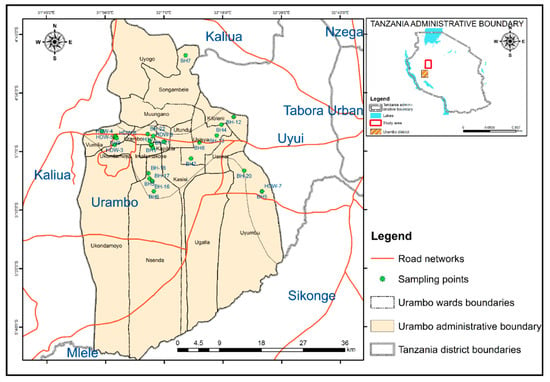
Figure 1
Open AccessPerspective
Impact of Climate Change on the Primary Agricultural Sector of Greece: Adaptation Policies and Measures
by
Christos D. Tsadilas
Earth 2023, 4(4), 758-775; https://doi.org/10.3390/earth4040041 - 02 Oct 2023
Abstract
►▼
Show Figures
The wide acceptance that Climate Change (CC) is a reality, often taking extreme forms, has led to the development of strategies to mitigate climate change and the need to adapt to the new climate conditions. Greece has already developed a National Strategy for
[...] Read more.
The wide acceptance that Climate Change (CC) is a reality, often taking extreme forms, has led to the development of strategies to mitigate climate change and the need to adapt to the new climate conditions. Greece has already developed a National Strategy for Adaptation to Climate Change (NSACC), which has started to be implemented in 2016 in the 13 regions of the state by implementing relevant projects. The Primary Sector of Agriculture (PSA) is one of the most vulnerable sectors to CC in Greece. This analysis describes the main points of the national strategy for mitigation and adaptation, focusing on the adaptation strategy for the PSA. Most of the information included in the analysis comes from a multidisciplinary study organized by the Bank of Greece (BoG), which was used as a guide for the formulation of the NSACC. The analysis includes a comprehensive summary of the PSA adaptation policy to CC, an assessment of climate evolution in Greece with emphasis on the characteristics related to the PSA, estimations of the CC impact on plant and animal production, and the whole organization of the national effort for adaptation to CC. The entire organization of the work followed the framework of the BoG study and the methodologies used in this paper.
Full article
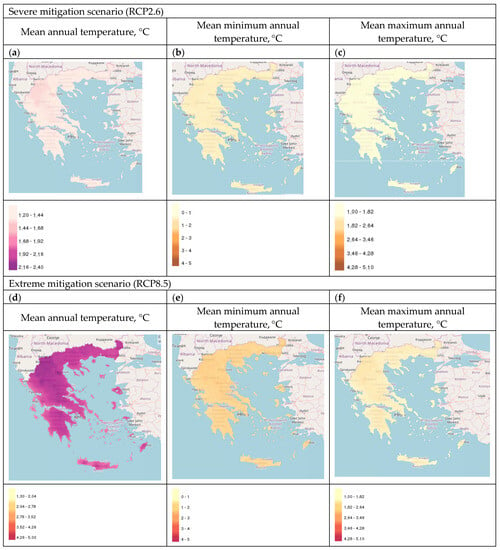
Figure 1
Open AccessOpinion
Transforming Great Salt Lake from Afterthought to Asset
by
Robert B. Sowby
Earth 2023, 4(4), 752-757; https://doi.org/10.3390/earth4040040 - 01 Oct 2023
Abstract
►▼
Show Figures
In a 36-year period that coincides with my lifetime, Great Salt Lake, one of the world’s largest terminal lakes and a critical ecosystem in the Western Hemisphere, went from its largest to its smallest recorded size. In this opinion piece, I argue that
[...] Read more.
In a 36-year period that coincides with my lifetime, Great Salt Lake, one of the world’s largest terminal lakes and a critical ecosystem in the Western Hemisphere, went from its largest to its smallest recorded size. In this opinion piece, I argue that the fundamental problem is that we Utahns and other stakeholders have treated Great Salt Lake as an afterthought instead of an asset. I describe the conditions that led to this point, some transformations now taking place, and the new hope that the lake will recover.
Full article
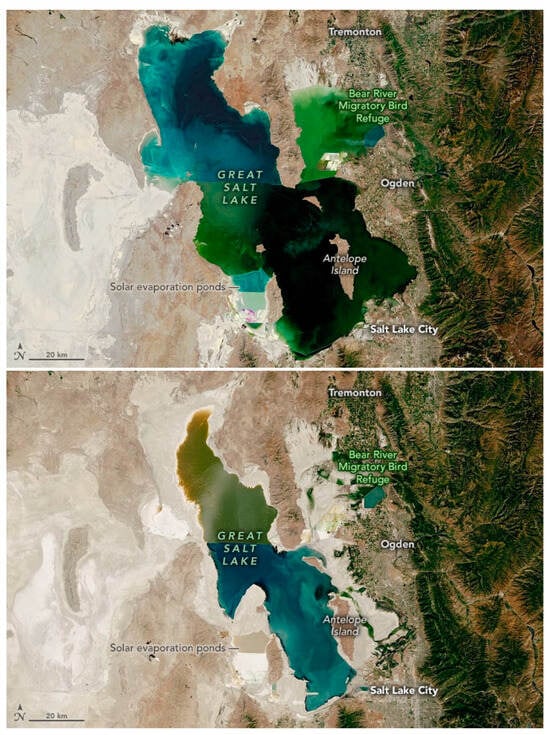
Figure 1
Open AccessArticle
Predicting Future Land Use Utilizing Economic and Land Surface Parameters with ANN and Markov Chain Models
by
Ankush Rani, Saurabh Kumar Gupta, Suraj Kumar Singh, Gowhar Meraj, Pankaj Kumar, Shruti Kanga, Bojan Đurin and Dragana Dogančić
Earth 2023, 4(3), 728-751; https://doi.org/10.3390/earth4030039 - 15 Sep 2023
Cited by 4
Abstract
►▼
Show Figures
The main aim of this study is to comprehensively analyze the dynamics of land use and land cover (LULC) changes in the Bathinda region of Punjab, India, encompassing historical, current, and future trends. To forecast future LULC, the Cellular Automaton–Markov Chain (CA) based
[...] Read more.
The main aim of this study is to comprehensively analyze the dynamics of land use and land cover (LULC) changes in the Bathinda region of Punjab, India, encompassing historical, current, and future trends. To forecast future LULC, the Cellular Automaton–Markov Chain (CA) based on artificial neural network (ANN) concepts was used using cartographic variables such as environmental, economic, and cultural. For segmenting LULC, the study used a combination of ML models, such as support vector machine (SVM) and Maximum Likelihood Classifier (MLC). The study is empirical in nature, and it employs quantitative analyses to shed light on LULC variations through time. The result indicates that the barren land is expected to shrink from 55.2 km2 in 1990 to 5.6 km2 in 2050, signifying better land management or increasing human activity. Vegetative expanses, on the other hand, are expected to rise from 81.3 km2 in 1990 to 205.6 km2 in 2050, reflecting a balance between urbanization and ecological conservation. Agricultural fields are expected to increase from 2597.4 km2 in 1990 to 2859.6 km2 in 2020 before stabilizing at 2898.4 km2 in 2050. Water landscapes are expected to shrink from 13.4 km2 in 1990 to 5.6 km2 in 2050, providing possible issues for water resources. Wetland regions are expected to decrease, thus complicating irrigation and groundwater reservoir sustainability. These findings are confirmed by strong statistical indices, with this study’s high kappa coefficients of Kno (0.97), Kstandard (0.95), and Klocation (0.97) indicating a reasonable level of accuracy in CA prediction. From the result of the F1 score, a significant issue was found in MLC for segmenting vegetation, and the issue was resolved in SVM classification. The findings of this study can be used to inform land use policy and plans for sustainable development in the region and beyond.
Full article

Figure 1
Open AccessArticle
Global Sensitivity of Penman–Monteith Reference Evapotranspiration to Climatic Variables in Mato Grosso, Brazil
by
Marlus Sabino and Adilson Pacheco de Souza
Earth 2023, 4(3), 714-727; https://doi.org/10.3390/earth4030038 - 13 Sep 2023
Cited by 1
Abstract
►▼
Show Figures
Understanding how climatic variables impact the reference evapotranspiration (ETo) is essential for water resource management, especially considering potential fluctuations due to climate change. Therefore, we used the Sobol’ method to analyze the spatiotemporal variations of Penman–Monteith ETo sensitivity to the climatic variables: downward
[...] Read more.
Understanding how climatic variables impact the reference evapotranspiration (ETo) is essential for water resource management, especially considering potential fluctuations due to climate change. Therefore, we used the Sobol’ method to analyze the spatiotemporal variations of Penman–Monteith ETo sensitivity to the climatic variables: downward solar radiation, relative humidity, maximum and minimum air temperature, and wind speed. The Sobol’ indices variances were estimated by Monte Carlo integration, with sample limits set to the 2.5th and 97.5th percentiles of the daily data of 33 automatic weather stations located in the state of Mato Grosso, Brazil. The results of the Sobol’ analysis indicate considerable spatiotemporal variations in the sensitivity of ETo to climatic variables and their interactions. The dominant climatic variable responsible for ETo fluctuations in Mato Grosso is incident solar radiation (53% to 93% of annual total sensitivity—Stot), which has a more significant impact in humid environments (70% to 90% of Stot), as observed in the areas of the Amazon biome in the state. Air relative humidity and wind speed have higher sensitivity indices during the dry season in the Cerrado biome (savanna) areas in Mato Grosso (20% and 30% of the Stot, respectively). Our findings show that changes in solar radiation, relative humidity, and wind speed are the main driving forces that impact the reference evapotranspiration.
Full article
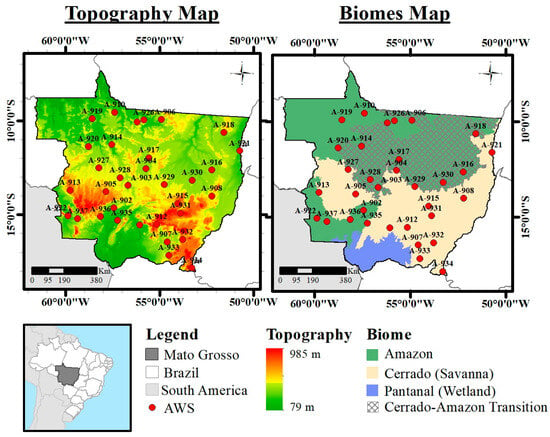
Figure 1
Open AccessArticle
Landslide Susceptibility Mapping Using Multi-Criteria Decision-Making (MCDM), Statistical, and Machine Learning Models in the Aube Department, France
by
Abdessamad Jari, Achraf Khaddari, Soufiane Hajaj, El Mostafa Bachaoui, Sabine Mohammedi, Amine Jellouli, Hassan Mosaid, Abderrazak El Harti and Ahmed Barakat
Earth 2023, 4(3), 698-713; https://doi.org/10.3390/earth4030037 - 09 Sep 2023
Cited by 3
Abstract
►▼
Show Figures
Landslides are among the most relevant and potentially damaging natural risks, causing material and human losses. The department of Aube in France is well known for several major landslide occurrences. This study focuses on the assessment of Landslide Susceptibility (LS) using the Frequency
[...] Read more.
Landslides are among the most relevant and potentially damaging natural risks, causing material and human losses. The department of Aube in France is well known for several major landslide occurrences. This study focuses on the assessment of Landslide Susceptibility (LS) using the Frequency Ratio (FR) as a statistical method, the Analytic Hierarchy Process (AHP) as a Multi-Criteria Decision-Making (MCDM) method, and Random Forest (RF) and k-Nearest Neighbor (kNN) as machine learning methods in the Aube department, northeast of France. Subsequently, the thematic layers of eight landslide causative factors, including distance to hydrography, density of quarries, elevation, slope, lithology, distance to roads, distance to faults, and rainfall, were generated in the geographic information system (GIS) environment. The thematic layers were integrated and processed to map landslide susceptibility in the study area. On the other hand, an inventory of landslides was carried out based on the database created by the French Geological Survey (BRGM), where 157 landslide occurrences were selected, and then RF and kNN models were trained to generate landslide maps (LSMs) of the study area. The generated maps were assessed by using the Area Under the Receiver Operating Characteristic Curve (ROC AUC). Subsequently, the accuracy assessment of the FR model revealed more accurate results (AUC = 66.0%) than AHP, outperforming the latter by 6%, while machine learning models results showed that RF gave better results than kNN (<7.3%) with AUC = 95%. Following the analysis of LS mapping results, lithology, distance to the hydrographic network, distance to roads, and elevation were the four main factors controlling landslide susceptibility in the study area. Future mitigation and protection activities within the Aube department can benefit from the present study mapping results, implicating an optimized land management for decision-makers.
Full article
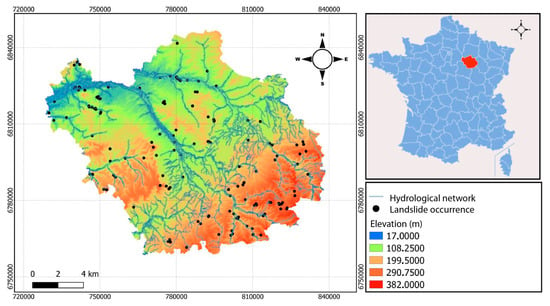
Figure 1
Open AccessOpinion
Edaphosphere: A Perspective of Soil Inside the Biosphere
by
Brian Herreño, Federico De la Colina and María José Delgado-Iniesta
Earth 2023, 4(3), 691-697; https://doi.org/10.3390/earth4030036 - 08 Sep 2023
Cited by 1
Abstract
►▼
Show Figures
The integration of soil into ecology in the current climate crisis is essential for correct environmental management. Soil is a part of ecosystems; above all, it is a component of the biosphere. It is necessary to establish a definition of soil that integrates
[...] Read more.
The integration of soil into ecology in the current climate crisis is essential for correct environmental management. Soil is a part of ecosystems; above all, it is a component of the biosphere. It is necessary to establish a definition of soil that integrates biota and biodiversity without losing sight of the historical development of edaphology, the science that studies soil. In this opinion article, we proposes a definition for all soils grouped together in the edaphosphere, which is, in fact, a subsystem of the biosphere. In addition, we highlight the importance of the definition of soil provided by Vasily Dokuchaev, the founder of edaphology, with respect to the integration of soil into the biosphere and the differences between the concepts of pedosphere and edaphosphere.
Full article

Figure 1
Open AccessArticle
Mapping Is Caring: Fostering Forest Preservation through Young Orang Rimba Initiatives
by
Anang Widhi Nirwansyah, Bianca Inez-Pedro, Abdel Mandili, Suwarno and Elly Hasan Sadeli
Earth 2023, 4(3), 676-690; https://doi.org/10.3390/earth4030035 - 07 Sep 2023
Abstract
►▼
Show Figures
The UN Convention on the Rights of the Child, Article 12, states that young people should be able to participate in issues that affect them. In this study, the indigenous Orang Rimba community examines the natural resources of their area through mapping so
[...] Read more.
The UN Convention on the Rights of the Child, Article 12, states that young people should be able to participate in issues that affect them. In this study, the indigenous Orang Rimba community examines the natural resources of their area through mapping so that the community can be more aware of environmental changes and at the same time their culture can be preserved. This research employs participatory resource mapping (PRM) to gather information about how young Orang Rimba view the forest in relation to customs. The study includes workshops on using GPS and GIS as well as resource mapping activities in the forest ecosystem. Through the participatory resource mapping, the study successfully maps 12 sacred places, 6 animal sites, and 14 medicinal plants in a short survey. The young Orang Rimba were also capable of addressing current environmental issues, including deforestation events, and simultaneously protecting the forest through local cultural practices. The study recommends involving indigenous communities in natural resource protection and awareness through mapping activities from a young age.
Full article
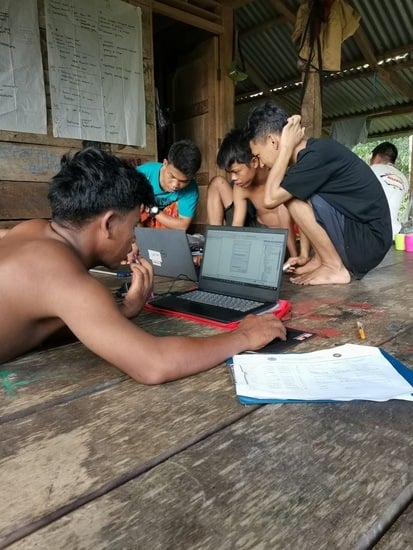
Graphical abstract
Open AccessArticle
Geospatial Multi-Criteria Evaluation Using AHP–GIS to Delineate Groundwater Potential Zones in Zakho Basin, Kurdistan Region, Iraq
by
Wassfi H. Sulaiman and Yaseen T. Mustafa
Earth 2023, 4(3), 655-675; https://doi.org/10.3390/earth4030034 - 01 Sep 2023
Cited by 1
Abstract
►▼
Show Figures
Groundwater availability in the Zakho Basin faces significant challenges due to political issues, border stream control, climate change, urbanization, land use changes, and poor administration, leading to declining groundwater quantity and quality. To address these issues, this study utilized the Analytic Hierarchy Process
[...] Read more.
Groundwater availability in the Zakho Basin faces significant challenges due to political issues, border stream control, climate change, urbanization, land use changes, and poor administration, leading to declining groundwater quantity and quality. To address these issues, this study utilized the Analytic Hierarchy Process (AHP) and geospatial techniques to identify potential groundwater sites in Zakho. The study assigned weights normalized through the AHP eigenvector and created a final index using the weighted overlay method and specific criteria such as slope, flow accumulation, drainage density, lineament density, geology, well data, rainfall, and soil type. Validation through the receiver operating characteristic (ROC) curve (AUC = 0.849) and coefficient of determination (R2 = 0.81) demonstrated the model’s accuracy. The results showed that 17% of the area had the highest potential as a reliable groundwater source, 46% represented high-to-moderate potential zones, and 37% had low potential. Flat areas between rivers and high mountains displayed the greatest potential for groundwater development. Identifying these potential sites can aid farmers, regional planners, and local governments in making precise decisions about installing hand pumps and tube wells for a regular water supply. Additionally, the findings contribute to the development of a sustainable groundwater management plan, focusing on improving water usage and protecting water-related ecosystems in the region. Identification of the optimum influencing factors, arrangement of the factors in a hierarchy, and creation of a GWPI map will allow further planning for groundwater preservation and sustainability. This project can be conducted in other areas facing droughts.
Full article

Figure 1
Open AccessEditor’s ChoiceArticle
Interpretation of Fluoride Groundwater Contamination in Tamnar Area, Raigarh, Chhattisgarh, India
by
Mirza Kaleem Beg, Navneet Kumar, S. K. Srivastava and E. J. M. Carranza
Earth 2023, 4(3), 626-654; https://doi.org/10.3390/earth4030033 - 22 Aug 2023
Cited by 1
Abstract
►▼
Show Figures
A high concentration of fluoride (F−) in drinking water is harmful and is a serious concern worldwide due to its toxicity and accumulation in the human body. There are various sources of fluoride (F−) and divergent pathways to enter
[...] Read more.
A high concentration of fluoride (F−) in drinking water is harmful and is a serious concern worldwide due to its toxicity and accumulation in the human body. There are various sources of fluoride (F−) and divergent pathways to enter into groundwater sources. High F− incidence in groundwater was reported in Raigarh district of Central India in a sedimentary (Gondwana) aquifer system. The present study investigates the hydrogeochemistry of groundwater in the Tamnar area of Raigarh district to understand the plausible cause(s) of high F− concentration, especially the source(s) and underlying geochemical processes. Groundwater samples, representing pre-monsoon (N = 83), monsoon (N = 20), and post-monsoon (N = 81) seasons, and rock samples (N = 4) were collected and analyzed. The study revealed that (i) groundwater with high F− concentration occurs in the Barakar Formation, which has a litho-assemblage of feldspathic sandstones, shales, and coal, (ii) high F− concentration is mainly associated with Na-Ca-HCO3, Na-Ca-Mg-HCO3, and Na-Mg-Ca-HCO3 types of groundwater, (iii) the F− concentration increases as the ratio of Na+ and Ca2+ increases (Na+: Ca2+, concentration in meq/l), (iv) F− has significant positive correlation with Na+ and SiO2, and significant negative correlation with Ca2+, Mg2+, HCO3−, and TH, and (v) high F− concentration in groundwater is found in deeper wells. Micas and clay minerals, occurring in the feldspathic sandstones and intercalated shale/clay/coal beds, possibly form an additional source for releasing F− in groundwater. Feldspar dissolution coupled with anion (OH− or F−) and cation (Ca2+ for Na+) exchange are probably the dominant geochemical processes taking place in the study area. The higher residence time and temperature of groundwater in deeper aquifers also play a role in enhancing the dissolution of fluorine-bearing minerals. Systematic hydrogeochemical investigations are recommended in the surrounding area having a similar geologic setting in view of the potential health risk to a large population.
Full article

Figure 1
Open AccessArticle
Spatio-Temporal Evolution of Rainfall over the Period 1981–2020 and Management of Surface Water Resources in the Nakanbe–Wayen Watershed in Burkina Faso
by
Wennepinguere Virginie Marie Yameogo, You Lucette Akpa, Jean Homian Danumah, Farid Traore, Boalidioa Tankoano, Zezouma Sanon, Oumar Kabore and Mipro Hien
Earth 2023, 4(3), 606-625; https://doi.org/10.3390/earth4030032 - 18 Aug 2023
Abstract
►▼
Show Figures
Spatio-temporal analysis of rainfall trends in a watershed is an effective tool for sustainable water resources management, as it allows for an understanding of the impacts of these changes at the watershed scale. The objective of the present study is to analyze the
[...] Read more.
Spatio-temporal analysis of rainfall trends in a watershed is an effective tool for sustainable water resources management, as it allows for an understanding of the impacts of these changes at the watershed scale. The objective of the present study is to analyze the impacts of climate change on the availability of surface water resources in the Nakanbe–Wayen watershed over the period from 1981 to 2020. The analysis was conducted on in situ rainfall data collected from 14 meteorological stations distributed throughout the watershed and completed with CHIRPS data. Ten precipitation indices, recommended by the ETCCDI (Expert Team on Climate Change Detection and Indices), were calculated using the RClimDex package. The results show changes in the distribution of annual precipitation and an increasing trend in annual precipitation. At the same time, a trend towards an increase in the occurrence and intensity of extreme events was also observed over the last 4 decades. In light of these analyses, it should be emphasized that the increase in precipitation observed in the Nakanbe–Wayen watershed is induced by the increase in the occurrence and intensity of events, as a trend towards an increase in persistent drought periods (CDD) is observed. This indicates that the watershed is suffering from water scarcity. Water stress and water-related hazards have a major impact on communities and ecosystems. In these conditions of vulnerability, the development of risk-management strategies related to water resources is necessary, especially at the local scale. This should be formulated in light of observed and projected climate extremes in order to propose an appropriate and anticipated management strategy for climate risks related to water resources at the watershed scale.
Full article
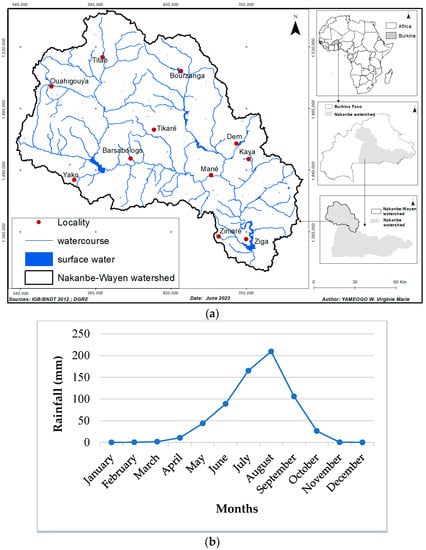
Figure 1
Highly Accessed Articles
Latest Books
E-Mail Alert
News
Topics
Topic in
Agronomy, Climate, Earth, Remote Sensing, Water
Advances in Crop Simulation Modelling
Topic Editors: Mavromatis Theodoros, Thomas Alexandridis, Vassilis AschonitisDeadline: 15 June 2024
Topic in
Climate, Earth, Land, Remote Sensing, Water
Effects of Climate Change on Geomorphology, Water Geochemistry and Pollution
Topic Editors: Matteo Gentilucci, Maurizio BarbieriDeadline: 28 February 2025
Topic in
Earth, GeoHazards, IJGI, Land, Remote Sensing, Smart Cities, Infrastructures, Automation
Machine Learning and Big Data Analytics for Natural Disaster Reduction and Resilience
Topic Editors: Isam Shahrour, Marwan Alheib, Anna Brdulak, Fadi Comair, Carlo Giglio, Xiongyao Xie, Yasin Fahjan, Salah ZidiDeadline: 30 June 2025











